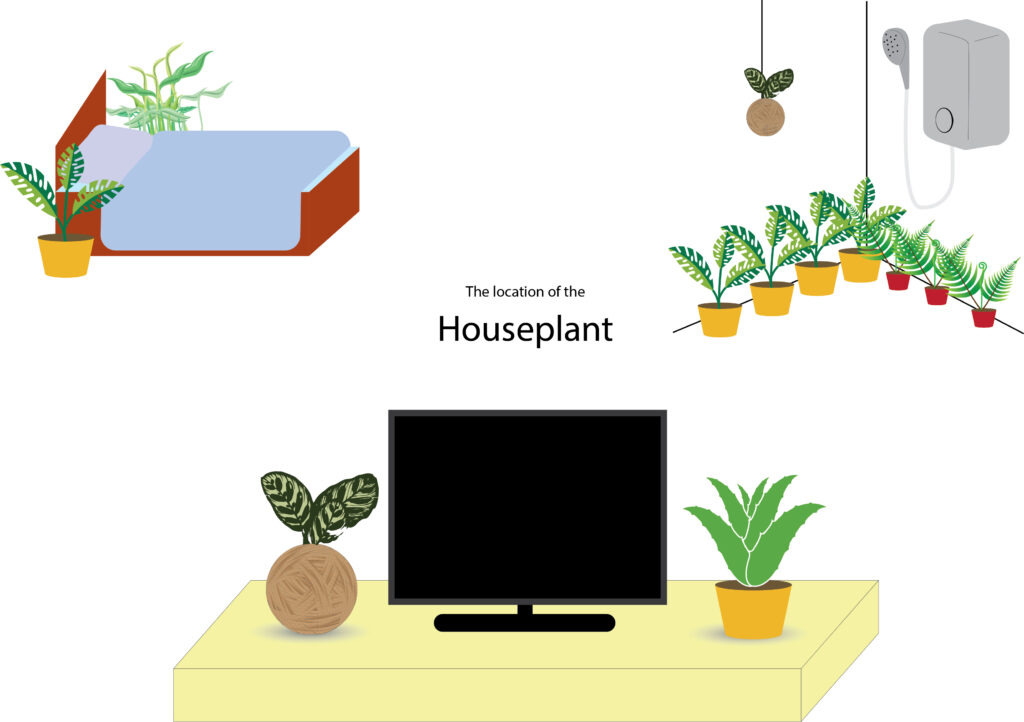It is undeniable that modern green ensures green positivity for us especially those who work from home in the current global pandemic. A room with modern green, not only provides natural positivity but also supply plenty of fresh air to us by eliminating toxic substances from the air. Other than the miniature indoor landscaping planting such as bonsai, kokedama, and terrarium, the most popular way would be growing houseplants in the dwelling. There is a wide range of houseplants to choose from, such as epiphytes like air plants, orchids, and ferns, shrubs, or small plants like the vining plants, aroids, monstera, philodendron, and fig, and succulents like sansievera and aloe vera. However, where to place them is a vital issue.
First of all, we must avoid planting any plants in the bedroom. The ideal location in the house should have constant good ventilation. Bedrooms are usually not well-ventilated especially those rented properties that are locked for most of the time in order to prevent splash of rain and the entry of small animals like birds or bugs. The fluctuations of the temperature between morning, afternoon, and evening may also cause the plants to die. Besides, plants emit carbon dioxide and compete for oxygen with us during the night which interferes with sleeping quality. Usually, the competition for oxygen is not as severe as to be a health threat but the presence of plants is an open invitation to insects and bugs like mosquitoes or centipede, which are annoying and healthy detrimental. Also, microbes like fungus may grow in soil and a high density of fungus spore in the air is harmful to people who are allergic to microbes. Another disadvantage is that the water droplet after watering may damage or leave a watermark on the furniture in the bedroom or become a breeding area for mosquitoes.
A bathroom could be a great place to grow indoor plants due to the high humidity that is favored by many plants that absorb moisture from the air. Having plants in a bathroom with slight decoration using rocks could be a great idea that mimics a jungle environment. Not to mention that you can use the showerhead to water them without worrying about the drainage issue, which is easy and fun. Just don’t forget to install a prefilter on the drainage to avoid the clogging of the piping system by tiny soil or rocks. However, it is recommended to avoid hot baths because the hot steam may exceed the tolerance range for some plant species and cause irreversible damages to their fragile leaves. Especially for those epiphytes with thinner leaves like some air plants and certain ferns, which are sensitive to heat. Also, the light should be moderate to sufficient depending on the demand of the plants, it is either to have the plants that are shades-loving or install an artificial lighting system.
Alternatively, the living room could be a better option for indoor plants that require moderate lights. Almost all indoor plants are great fits in the living room. Pay attention to avoid places near electrical sources like switches, plugs, and electrical gadgets as the water might cause electrical problems. It is recommended to have a tray or saucer under the pot to avoid the leak of excess water. The options are available to buy pots that designed to have an indicator showing the water or soil dryness level that wired with a detector in the soil. Besides, a self-watering system can be installed with pipes and drippers that are set to have an automated watering program set. Or drippers made of water bottles in which the flow of the water can be manually adjusted to drip the water without the need for watering.
A kitchen is a great place for houseplants, with its excellent air circulation and close to the water faucet. But a kitchen that produces concentrated oily smokes should be avoided because the oil molecules that smear on leaves surfaces will lead to blockage of stomata which is essential for plant survival with functioning breathing and transpiration. Also, avoid locations next to heat sources like a refrigerator, oven, microwave, and stove that accumulate hot dry air. Other than the locations mentioned above, the balcony would be a great area for the woody plants that thrive under full sun and those plants that adapt well in inconsistent weather.
Indoor plants are excellent air purifiers in which toxic compounds like toluene, benzene, and formaldehyde could be minimized. Of course, to have indoor plants in the house is like a two-edged sword, especially for those who have active pets and young kids in their house, large plants should be avoided in the play area and most ornamental plants are not edible and could be toxic if consumed.

Further reading: